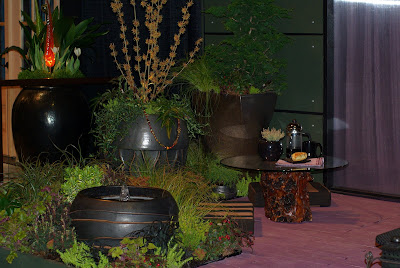The great thing about this lens is how fast it is. That means it is great in low-light. The low f number means it collects a lot more light, with less camera shake (since the photographer can use a faster shutter speed) than other lenses. Even in dimmly lit areas, there is enough light to use this lens without a flash.

What would the same image look like with a flash? Here it is:

Which looks more natural?
There is a challenging characteristic to working with this lens: shallow depth of field.
The nature of an f/1.4 lens is that when the photographer opens up the aperture (like at 1.4), depth of field narrows. I'm not going to call this a disadvantage. It's more of a characteristic. Sometimes the shallow depth of field is an advantage. It allows the photograph to keep only certain items in focus, and allows the background and foreground to go out of focus.
You can see the effect here:
 The sign is mostly in focus, the background isn't. Neither are things that are closer to the camera than the sign. There is a subtle out of focus circle around the center of the image.
The sign is mostly in focus, the background isn't. Neither are things that are closer to the camera than the sign. There is a subtle out of focus circle around the center of the image.Here's another example.
 The phrase, "This versatile modular planter" is the only text that's in focus. That's because of the shallow depth of field.
The phrase, "This versatile modular planter" is the only text that's in focus. That's because of the shallow depth of field.If I used a higher f-number, the entire item would be in focus. But because that would limit the light I capture, the image would likely be useless. Out doors, in the sun, this is not likely to be an issue. In the convention center with limited light, however, I chose to give up perfect focus in exchange for better light.
If you have used a film SLR in the past, you probably have a good idea of what you can do with a 20mm lens, a 50mm lens, or a 1000mm lens.
In a digital camera, those number don't really mean the same thing. To get the film equivalent for the Pentax, multiple the lens size by 1.5.
So a 50mm lens on DSLR is roughly equivalent to a 75mm lens for a film camera. I've known this for a while, but didn't intuitively grasp it until this week when I was tripping all over people as I took more and more steps back from my subject.
I can't use my 50mm lens to take pictures of big things. It simply can't handle the wide angles.
To photograph parts of the show gardens, I had to step back 20-30 feet, just to get most of the scene in the image. In a crowded convention hall, that means you don't get the shot. There are too many people getting between photographer and subject.
My 50 mm is great for most things, but it just can't cut it for photographing buildings or structures. It's gets in too tight and hides the whole thing from the viewer. But it's perfect for taking pictures of smaller objects in lower light. And it will be great for portraits.

3 comments:
Nice shots and well explained. It's been quite a while since I've shot 35 mm film. I had a macro-focusing 50 mm, but it was only f 1.8. Plenty adequate for most work, but not the best in low-light situations. For individual portraits, I liked a 90-mm lens the best. Anyway, good work. I enjoy my visits here.
Oh brother here you go again. you are going to get me in trouble if you don't stop finding all of these great lenses!!
Happy week ahead I hope!!:-))))
@Secondary Roads: Thanks. It took me a while to grasp depth of field when I was learning it. The instant results of digital photography make it easier to see that in action. In my 35mm days I had just two zoom lenses to work with, but now I'm trying to get a little better. A 90mm on 35mm would likely be a bout a 60mm on a DSLR.
@Shinade: You found me out. I'm trying to drive you to the poor house with a trunk fool of lenses. Bwah Ha Ha ha ha. Or something like that.
Post a Comment